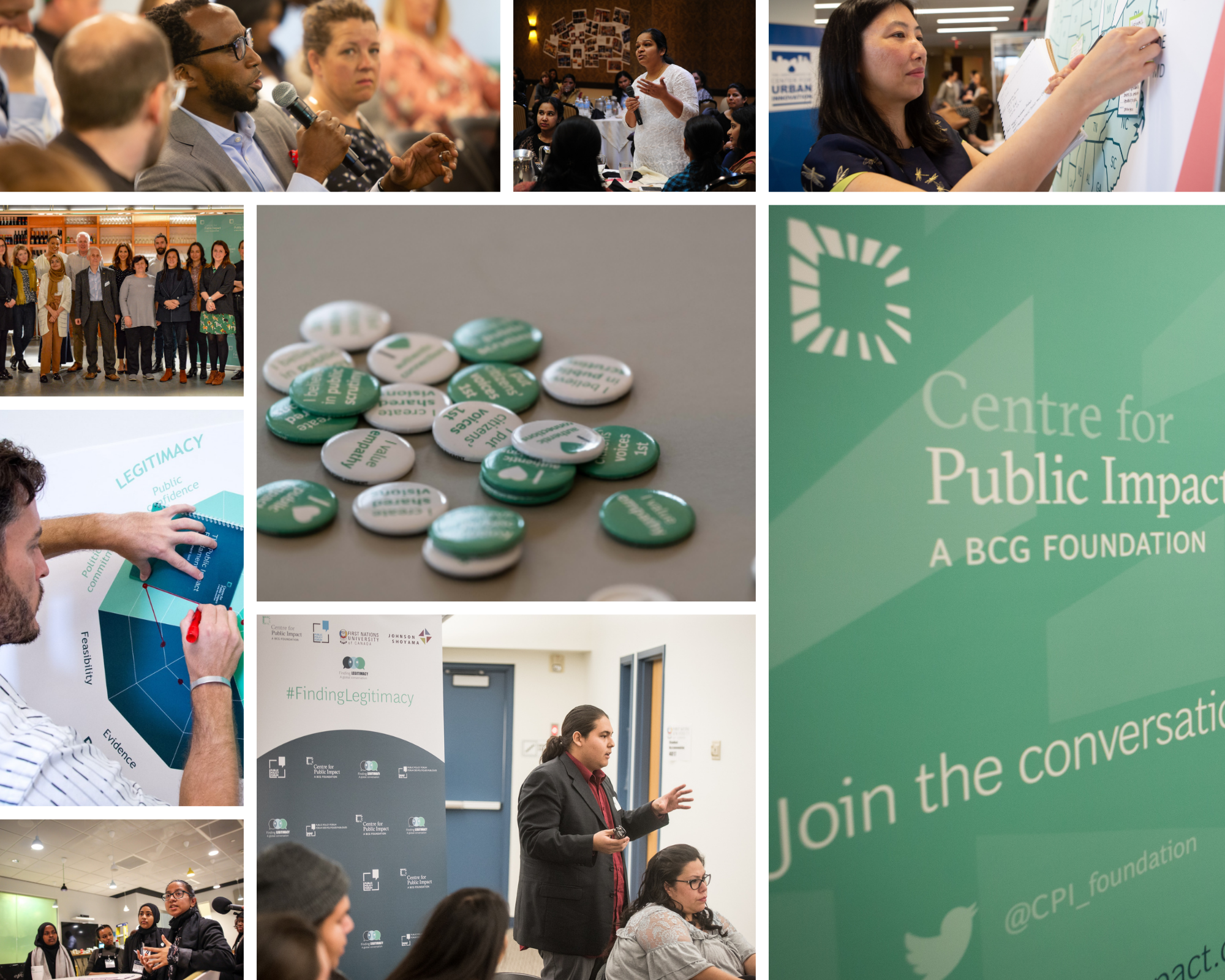

Is CPI an inclusive place to work? Tackling bias in recruitment and improving the employee lifecycle
Article highlights
.@CPI_foundation are on a journey to become more inclusive. 1st in the #DEIatCPI series, we share learnings on fairer recruitment processes
Share article.@cpi_rachel & Rebecca have been working to rethink @CPI_foundation recruitment processes to become more diverse, equitable & inclusive
Share article'Diversity enriches commitment to a just society & enhances ability to enact changes so govs help to better respond to complex challenges'
Share articlePartnering for Learning
We put our vision for government into practice through learning partner projects that align with our values and help reimagine government so that it works for everyone.
As first indicated in a blog from one of our colleagues earlier this year, like many organisations in 2020, the Centre for Public Impact has been on a journey to better understand and articulate why diversity, equity and inclusion are so vital to helping us achieve our mission and feel psychologically safe as we work to achieve our mission together.
Pulling on the varying insights and perspectives of our over 40 person strong global team that spans from Australia to California, we started by co-creating a Diversity, Equity and Inclusion (DEI) Policy that feels right for where our team is at this point in our journey - and we've set ourselves the goal of reviewing it again early next year.
Read CPI's Diversity, Equity and Inclusion Policy
We've given ourselves the explicit goal to “attract and support a diversity of backgrounds, experience, talent, and thought” because we recognise that “diversity enriches our commitment to a more just society and enhances our ability to enact change so governments help societies to better respond to complex challenges.” However, we want to remain self-reflective and transparent about where we're falling short of our aims: “We commit to struggling with the conflicts inherent to what we do, openly and transparently, with the hopes that by doing so the solutions can have a ripple effect far beyond our organisation's boundaries.”
Diversity enriches our commitment to a more just society and enhances our ability to enact change so governments help societies to better respond to complex challenges.
With our policy written and approved by the board, we were ready to delve deeply into the work that needed to be done around the four areas outlined in the policy and our roadmap: Recruitment and Advancement, Psychological Safety, External Communications and Programmatic Work.
As part of our commitment to being transparent about this process, we've decided to share what we are learning as we go in a series of blogs to help foster an open discussion and knowledge sharing around this important topic. First up: how we're working to make CPI “an employer of choice, recruiting, attracting, and retaining diverse staff (to include those from historically under-represented groups) with the full range of competencies needed to excel at our purpose.”
Continuing to address bias in our hiring systems
At CPI, we want to take an intersectional approach to increasing diversity, but there were some glaring areas where we knew we needed to focus our efforts early on: particularly around racial and ethnic diversity. It's important to us that we're able to speak from a position of experience about the challenges historically underrepresented people have engaging with and within government, and we knew we didn't have enough diversity of that experience across our team.
When we started working with the Applied platform in 2018, we hoped to be able to recruit amazing, talented and diverse people to our team without any bias. However, earlier this year we discovered that the platform was not the panacea for which we had hoped.
Our data showed that Black, Asian and Minority Ethnic (BAME) candidates in the UK and North America were starting the application process but not progressing through to the interview stages. This made us question how we were using the platform, so we brought in Applied to help us investigate.
Data from the previous 12 months showed that hiring managers were not following the correct process in the platform, so Applied was unable to provide accurate data on BAME applicants. Additionally, the people at CPI using the platform were all using this differently so there was no consistency in the process. To rectify these problems we undertook a number of steps:
Took a deep dive into Applied's Knowledge Centre to help us improve our hiring process
Provided training to the UK-based staff who had been using the platform on how best to use it
Created a database of sift questions that would speak to a broader pool of applicants, as well as job advert templates to ensure consistency
Extended use of the Applied platform to North America and Australia/New Zealand to create more consistency in our recruitment processes across teams
Identified ways to increase diversity of people who start applications
On the last point, we searched for recruitment agencies who specialise in placing diverse candidates and have started discussions with Creative Access, who specialise in the UK nonprofit sector. We also decided to advertise more consistently for roles on LinkedIn, which has so far resulted in a 65% increase in applications overall - and a 12% increase in Black applicants specifically - compared to previous roles.
Whilst these changes have yielded some encouraging results, we know that we are still learning and need to do much more to increase diversity in our recruitment pipeline. To that end, we plan to explore how other companies are using the Applied platform to increase their diversity - with a particular interest in the recruitment of BAME candidates. We have also committed ourselves to continually review the data on Applied to show successes and failures so we can modify our approach if needed.
However, we also recognise that recruitment is only one aspect of the employee experience at CPI, so we also turned to other aspects of the employee lifecycle.
Beyond recruitment: looking at the employee lifecycle
In order to understand how to improve the employee experience, we started conducting exit interviews. This may sound fairly standard, but we wanted to make sure they were useful and not just a ‘tick the box' exercise. Therefore, we've created the necessary space to review the results of exit interviews each quarter and take any common messages or themes back to the team to identify areas of improvement.
From this, we recognised that our onboarding process was outdated and somewhat impersonal. We saw that the Trello board we were using to guide new joiners through their first week at CPI offered a very impersonal experience that was not helpful in getting to know the organisation. According to Disruptive HR, 33% of employees make a decision on whether to stay or leave at a company in their first month of employment, so it was imperative that we change this.
Therefore, we decided to undertake a few activities to help make the onboarding process more engaging. We created a pre-boarding questionnaire asking new joiners questions to get to know them better before their first day. We also overhauled our onboarding Trello board, transforming it into a customisable template which can be adapted to each new joiner. It also includes onboarding tasks from the first day, first week, first month, and throughout the year. We broke tasks down into learning, doing and connecting activities because we recognise that trying to build connections in a new job (especially when everyone is working remotely) is really difficult.
According to Disruptive HR, 33% of employees make a decision on whether to stay or leave at a company in their first month of employment.
Another issue raised in recent exit interviews was that people did not feel they were recognised for their hard work. Sure, people send out emails or Slack messages congratulating colleagues for a job well done, but these can often get lost in the trail of messages.
Since we like to do things a bit differently at CPI, we went out to look for a platform that would not only help us reward and recognise outstanding work, but also help us connect better as a team, which was something that was repeatedly highlighted in exit interviews and staff surveys. We settled on MoWork because their platform is centred around “enabling individuals, teams and organisations to capture, celebrate and elevate moments at work.” Best of all, recognition can be aligned with our values and the team can be rewarded with vouchers at many popular stores and restaurants. We're in the middle of getting it all set up for a global roll out in January 2021, so we'll let you know how it goes!
The journey continues
We recognise these are small steps to tackle bias in recruitment and improve the employee lifecycle, and we recognise that our journey has only just begun. The next blog in our series will take a closer look at one of the most important and therefore challenging aspects of the employee lifecycle: creating a psychologically safe work environment. We'll explore how we've been investigating the dynamics of culture, power and conflict and how these forces influence and impact diversity, equity and inclusion at CPI.
In the meantime, we welcome your thoughts, reflections and suggestions on how we might continue to improve the diversity of our applicant pool, make better use of Applied and other recruitment tools to help reduce bias, and finding more inclusive ways to onboard and celebrate our incredible team.

Diversity, Equity and Inclusion at CPI
We are on a journey to better understand and articulate why diversity, equity and inclusion are so vital to helping us achieve our mission and feel psychologically safe as we work to achieve it. In this blog series we are committing to transparency by sharing our learning.
You may also be interested in...


Local Government Chronicle: Learning to listen again in local government
